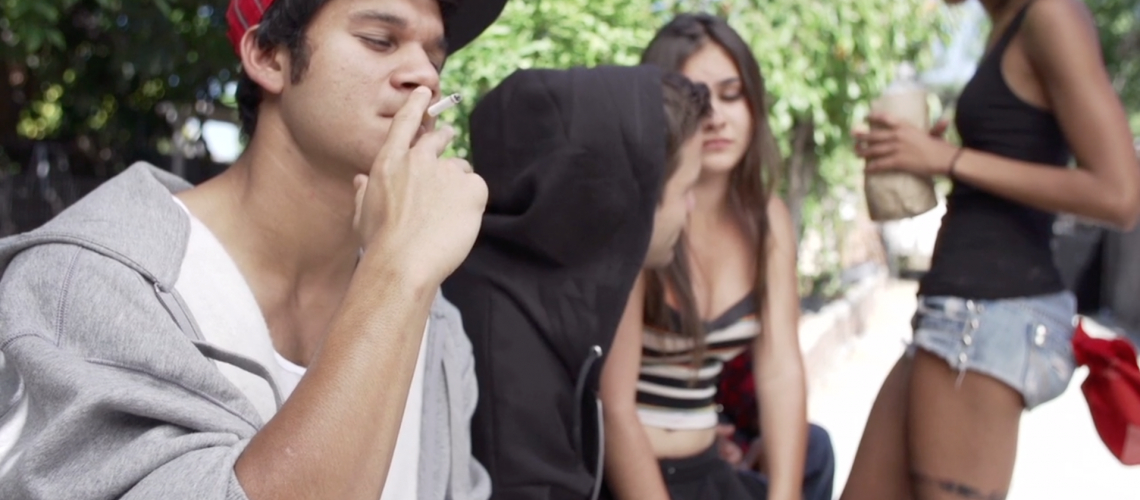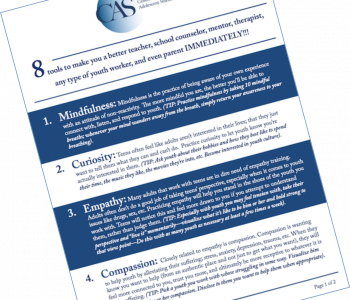

Sam Himelstein, PhD
Sam Himelstein is the founder and CEO of the Center for Adolescent Studies, Inc. He is passionate about working with youth and training the professionals that serve them.
3 Tips for Using Mindfulness in Substance Abuse Treatment with Adolescents
There’s a significant need for substance abuse prevention and intervention with young people, especially those adversely affected by the many issues youth deal with; drugs, achievement, depression, anxiety, trauma, etc.
Mindfulness, the practice of being aware of one’s mental, emotional, and physical experience in the present moment with an attitude of non-reactivity, has surged as a treatment intervention over the past 30 years. The addiction field has also started to incorporate mindfulness as an intervention for substance abusers and addicts. And this is gaining ground in the field of adolescent substance abuse as well.
Mindfulness can be cultivated via meditation (and there are various forms of mindfulness meditations) or by simply bringing the above qualities into consciousness while doing daily activities; talking with a friend, working out, eating, etc.
What’s key is that mindfulness enhances our ability to be non-reactive. This is key in drug treatment because oftentimes we seek immediate gratification; we want to feel good right now, or we want the negative feeling we’re experiencing to stop right now. This leads to reactive thinking, feeling, and behaving, and can be a catapult for drug use (especially for teens).
When we practice mindfulness we practice responding to our experience with a non-reactive, non-judgmental attitude. This helps us maintain autonomy over our behavior. We may not have control over whether a craving for a drug arises, but we can control how we respond to such a craving. The irony is that when we practice simply observing the craving; letting it arise and letting it pass away (rather than actively trying to push it away or avoid it), we are left with more of an ability to regulate ourselves.
This blog post is simply an introduction to using mindfulness for teens dealing with substance abuse and will no doubt be expanded on in the future. I won’t be reviewing the many mindfulness meditation practices that can simply be taught, although I do recommend being familiar with all forms of formal mindfulness practices if you plan on teaching mindfulness to youth (especially those using drugs). Below are 3 simple tips for using mindfulness in substance abuse treatment with adolescents.
1) Start with the Relationship
I am highly biased toward the idea that the relationship is of utmost importance when working with adolescents, and this is especially true with adolescent substance abusers. Rather than entering into your counseling relationship with a youth and starting with the attitude of “I have this technique that’s going to help you stop using or lower your drug use,” start by putting explicit effort into relationship building. This is done in many ways, and I’m sure you can think of the relationships in your life and think about what qualities contribute to building strong, trusting, genuine relationships. Authenticity, compassion, the willingness to disclose about yourself (when appropriate of course), and knowing how to set boundaries skillfully are just a few qualities of building authentic relationships with adolescents. Don’t pass by the relationship and go straight into solutions-focused mode. It’s good practice to simply sit down with the young person the first time you meet and simply get to know him or her. Be curious about the life of the youth without prying for too much information. Ask about personal interests, if they’re pissed about having to be in counseling, and/or if there is in fact anything they want to learn about drugs. Be clear that you’re not there to change them or even tell them to stop doing drugs, that your role is to help them develop in self-awareness and make conscious decisions in their lives and that you want to build a genuine relationship. This is how you start with the relationship. This builds trust and receptivity and will lead to the young person being more willing to try mindfulness meditation.
2) Start with Brief, Easy-to-Follow Techniques with Immediate Effects
A question I get asked routinely is, “is there a specific mindfulness meditation that works best for youth?” As a field we often define the term mindfulness very broadly but neglect to mention that there are numerous mindfulness meditations through which we can practice mindfulness.
Mindfulness of Deep Breathing is a technique that engages youth in slow, deep breathing. The instruction is to simply breathe slowly and deeply, and whenever the mind wanders to bring it back to the breath. The mind is oftentimes easily consumed by the physicality of breathing deep and doesn’t wander as easily as in a standard mindfulness of the breath meditation (where the instruction is to be mindful of the breath without manipulating it to be deep or shallow) and the deep breathing of the diaphragm activates the parasympathetic nervous system which in turn activates the relaxation response. Thus youth oftentimes report feeling relaxed or calm immediately following the meditation. Sometimes youth even report feeling a “natural high” after I’ve taught this to them for the first time.
The BodyScan is a mindfulness meditation where you systematically scan the physical sensations in your body from head to feet or feet to head. The BodyScan is an easy to understand, easy to follow technique that oftentimes leaves youth feeling relaxed, calm, and sometimes even sleepy (and it’s good to recommend they try meditation to go to sleep). What’s good about this technique is that the young person always knows what they’re supposed to be doing because you’re constantly guiding them through different parts of the body.
Remember, these techniques are simply “hooks.” We’re using these to get the young people we work with to “buy-in” to what we’re offering in some way. Youth are unique so some will be drawn to particular techniques, but research has shown that using the above exercises to start can be particularly skillful. Start with no longer than 5 minutes and work your way up to higher amounts of formal meditation as the treatment and relationship progresses.
3) Use Informal Mindfulness Techniques
Alongside mindfulness meditation, incorporate informal mindfulness techniques as well. This is when you have your client/student practice mindfulness without actually assuming a particular sitting position and meditating (you can even facilitate these techniques without ever saying the word “meditation”).
Below are a couple informal techniques from a mindfulness-based substance abuse treatment curriculum for adolescents I co-authored:
The mindful check-in is a type of check-in in which the youth is directed to take a deep breath (or a few breaths) and then check in with his or her present-moment experience and report on it. Rather than simply blurting out “I feel fine,” or “I’m good,” the young person is encouraged to use descriptive words of her or his present-moment experience. This is a way to get an adolescent in a present-moment state of mind without formally meditating. You can use this at the beginning of a group, class, family, or one-on-one session. It’s also great to use the technique as a method to intervene when frustration, anger, or any strong emotion arises: “Could we pause for a moment and practice the mindful check-in?” … “Let’s pause and take a breath and notice how we’re feeling right now…” are great tools to check in with an angry client, a member of a group who’s acting out, or to facilitate deeper connection between family members.
STIC is a cognitive (mindfulness-based) acronym that stands for Stop, Take a breath, Imagine the future consequences, and Choose. Using a cognitive acronym is nothing new, and in fact there are many mindfulness-based acronyms: STOP (stop, take a breath, observe, proceed,), SOBER (stop, observe, breath, expand, respond), PEACE (pause, exhale, allow, choose, and engage), and there are many more. My colleague and I developed STIC because it tested well with the adolescents we were working with (incarcerated youth with co-occurring substance abuse and trauma). I encourage you to try different acronyms and potentially even develop your own if you feel you need something more culturally or sub-culturally appropriate for the youth you work with.
One way to teach STIC is by bringing the youth through a visualization where they think of the last time they had the chance to do drugs. Guide them through a visualization of the exact scene; where it is, what friends are there, etc. Then we have them think of themselves stopping what they’re doing physically, taking a breath, and imagining the possible consequences of their actions. Then we ask them to choose. The choice is theirs, not ours. It’s important to emphasize this as it will lead to greater receptivity (i.e., you’re not forcing anything on them) and of course it’s the truth.
I also like to pass out pre-made business cards with the STIC acronym on them. I encourage the youth I work with to simply look at it once a day, to remind themselves of the acronym. The more they remember, the greater chance they’ll put it into good use when necessary.
If you’re working in a group, it’s also good to utilize role-plays. I’d have the youth come up with different scenarios in which STIC could apply; drugs, anger and fighting, dealing with unjust interactions with authority like police, etc., and then we have them actually act out the scene and practice STIC out loud (by reciting STIC, going through the steps, and thinking out loud when it comes to the imagining the future consequences, for the sake of the group). The group usually gets a kick out of the activity and it’s a good way to diversify the way in which you facilitate groups as the normal talk therapy modality can get painfully boring to youth.
I also encourage youth to practice the STIC visualization on their own with situations they think will be difficult (e.g., friends offering them drugs, the urge to use, etc.). Don’t worry if youth write-off the technique at first. I’ve had many experiences where youth would say things like, “I don’t think something like this will work,” and would then report back to me that it did in fact work when they tried it in a time of need.
—
Building an authentic relationship, starting with brief and simple techniques, and using informal mindfulness are useful methods for incorporating mindfulness into substance abuse treatment with adolescents. Once that relationship gets strong, you can experiment further. I’ve facilitated advanced meditations for over 30 minutes before with teens, but that’s because I had the trust of the group, our relationships were authentic, and they were exposed to mindfulness in appropriate doses.
If you’re interested in learning more about incorporating mindfulness into substance abuse work with teens or would like to become a certified Mindfulness-Based Substance Abuse Treatment (MBSAT) facilitator, go to: https://courses.centerforadolescentstudies.com/mbsat
For further reading, check out these related posts:
3 Ways Traumatic Events Impact Teen Substance Abuse
Did You Ever Do Drugs? 3 Responses for Adults Working with Adolescents
The Five Major Types of Drugs Used by Teens
Substance Abuse Treatment Does NOT Happen in a Vacuum

